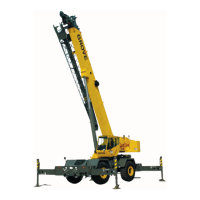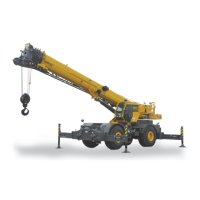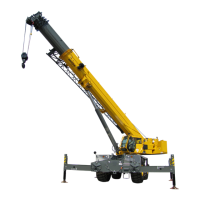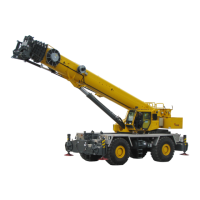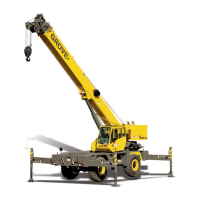POWER TRAIN RT880E SERVICE MANUAL
7-4 Published 11-10-2014, Control # 524-00
ELECTRONIC CONTROL SYSTEM
The engine control system is an electronically operated fuel
control system that also provides many operator and vehicle
features, as well as, reducing emissions while optimizing
engine performance.
The ECM performs diagnostic tests on most of its circuits
and will activate a fault code if a problem is detected in one of
these circuits. Along with the fault code identifying the
problem, a snapshot of engine operating parameters at the
time of fault activation is also stored in memory. Some fault
codes will cause a diagnostic lamp to activate to signal the
driver. The fault codes can be read on the control panel
display or with the correct service tools. The ECM
communicates with service tools supplied by Cummins
through a SAE J1939 data link.
The ECM also monitors the condition of the Decomposition
Tube and illuminate an indicator when it is getting filled with
urea and needs to be cleaned out. When the Decomposition
Tube becomes clogged, the ECM will control the exhaust
system cleaning process to clean the tube of urea.
Engine Control System Switches and
Indicator Lights
Engine Diagnostic/Speed Control Switch
The Engine Diagnostic/Speed Control Switch is a two
position maintained on/off rocker switch used to access the
engine fault codes or enable the control of the low engine
idle and engine RPM functions.
Diagnostic function — With the Ignition Switch in the RUN
position and the engine off, press the top of the Engine
Diagnostic/Speed Control Switch to view the engine fault
codes on the steering column display. If there is more than
one active engine fault code, use the Increment/Decrement
Switch to toggle forward and backward through the fault
codes. If there are no engine fault codes, zeroes will be
shown in the steering column display.
Engine low idle function — With the engine running and the
top of the Engine Diagnostic/Speed Control Switch pressed,
the engine low idle is adjusted using the Increment/
Decrement Switch.
Engine RPM function — With the engine running and the
bottom of the Engine Diagnostic/Speed Control Switch
pressed, the engine RPM is adjusted using the Increment/
Decrement Switch.
Increment/Decrement Switch
The Increment/Decrement Switch is a three position
momentary rocker switch with center maintained position
being off. Use this switch to toggle backward and forward
through active engine fault codes or adjust engine speed.
Diagnostic function — With the Ignition Switch in the RUN
position, the engine off, and the top of the Engine Diagnostic/
Speed Control Switch pressed, press the top or bottom of the
Increment/Decrement Switch to toggle forward and
backward through the engine fault codes shown on the
steering column display. If there are no engine fault codes,
zeroes will be shown in the steering column display.
Engine low idle function — With the engine running and the
top of the Engine Diagnostic/Speed Control Switch pressed,
press the top or bottom of the Increment/Decrement Switch
to increase or decrease the low engine idle.
Engine RPM function — With the engine running and the
bottom of the Engine Diagnostic/Speed Control Switch
pressed, the Increment/Decrement Switch is used to adjust
engine RPM. Quickly press the top of the switch once to go
to full engine RPM; quickly press the bottom of the switch
once to return to low engine idle. If the engine speed is below
the maximum RPM setting, pressing and holding the top of
the switch will cause the engine RPM to slowly increase;
release the switch when the desired RPM is attained. If the
engine speed is above the minimum RPM setting, pressing
and holding the bottom of the switch will cause the engine
RPM to slowly decrease; release the switch when the
desired RPM is attained.
Engine Stop Light
The Engine Stop Light is located in the steering column
gauge display. It is a red indicator light that illuminates to
signify a serious engine problem that requires the vehicle
and the engine to be stopped as soon as safely possible.
The engine should remain shut down until the fault can be
repaired.
In addition to alerting the operator of system faults, the
Engine Stop Light, in conjunction with the Engine Warning
Light, is used in the diagnostic operation of the engine
control system.
NOTE: When not using the diagnostic system, turn the
Engine Diagnostic Test Mode Switch to the OFF
position.
To check for active fault codes, turn the keyswitch to the OFF
position, and move the Engine Diagnostic Test Mode Switch
to the ON position. Turn the vehicle keyswitch to the ON
position. If no active fault codes are recorded, both lamps
stay off. If active fault codes are recorded, both lamps will
come on momentarily, then begin to flash one code of the
recorded faults.
Engine Warning Light
The Engine Warning Light is located in the steering column
gauge display. It is an amber indicator light that is a part of
the engine’s electronic control system and when illuminated,
gives the operator a signal that there is a engine problem
which must be corrected.

